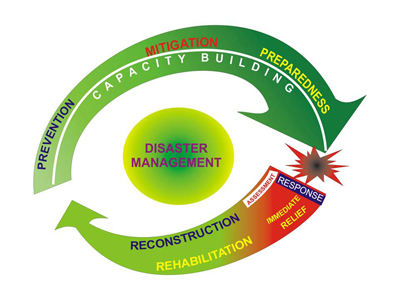-
Q. Critically evaluate the effectiveness of India’s disaster management framework. Suggest key reforms to strengthen disaster preparedness and resilience in the face of growing climate risks. (250 words)
16 Apr, 2025 GS Paper 3 Disaster ManagementApproach
- Define India’s disaster management framework.
- Evaluate its effectiveness in dealing with disaster preparedness and response.
- Identify gaps and suggest key reforms to improve resilience.
Introduction
India, a country frequently affected by diverse natural disasters, has developed a robust disaster management framework under the Disaster Management Act, 2005. However, India’s vulnerability to these disasters has been exacerbated by factors like climate change, rapid urbanization, and environmental degradation, which have heightened both the frequency and severity of such events.
Body
Effectiveness of India’s Disaster Management Framework:
- Institutional Framework and Financial Support: The establishment of the National Disaster Management Authorities (NDMA), State Disaster Management Authorities (SDMAs), and district-level agencies has enhanced coordination during disasters.
- For the period 2021–26, ₹68,463 crore has been allocated under the National Disaster Risk Management Fund (NDRMF).
- Of this, 80% is earmarked for the National Disaster Response Fund (NDRF), while 20% is allocated to the National Disaster Mitigation Fund (NDMF), reflecting a balanced focus on both immediate relief and long-term preparedness.
- For the period 2021–26, ₹68,463 crore has been allocated under the National Disaster Risk Management Fund (NDRMF).
- Focus on Preparedness: The National Disaster Management Plan (NDMP) emphasizes disaster preparedness, with state and local authorities having disaster management plans. Initiatives like the National Cyclone Risk Mitigation Project have enhanced early warning systems (Indian Meteorological Department's alerts) and shelter infrastructure.
- Community Engagement: The framework encourages Community-Based Disaster Management (CBDM) programs that involve local stakeholders, making the response more inclusive and context-specific.
- Programs like the ‘Village Disaster Management Plans’ have been effective in rural areas.
Limitations and Gaps:
- Inadequate Climate Adaptation Strategies: The increasing frequency and intensity of climate-related disasters like floods and droughts are not adequately addressed by current frameworks, as they lack a strong focus on climate adaptation.
- The government allocated ₹2,000 crore under the National Adaptation Fund for Climate Change (NAFCC) in 2021, but its implementation remains insufficient.
- Slow Response to Emerging Risks: The framework, while effective for traditional disasters like cyclones and earthquakes, struggles with emerging risks like heat waves, urban flooding, and landslides, due to inadequate forecasting and response systems.
- Weak Integration of Disaster Risk Reduction (DRR): There is a need for better integration of DRR into development planning.
- Urbanization without adequate disaster risk assessments often leads to disproportionate losses during disasters.
Key Reforms to Strengthen Preparedness and Resilience:
- Climate Resilience Strategy: Given the growing climate risks, India should incorporate climate-resilient infrastructure and DRR strategies into development projects, particularly in vulnerable areas.
- The Smart Cities Mission aims to build climate-resilient urban infrastructure with a focus on flood management and urban heat islands; the implementation requires faster scaling.
- Decentralized Disaster Management: Greater emphasis on decentralizing disaster management to the district and local levels would enhance timely decision-making and local-level resilience building.
- The capacity of Panchayats and Urban Local Bodies (ULBs) should be strengthened for localized response, including the integration of hyperlocal weather forecasting, to enhance disaster management and decision-making at the grassroots level.
- Integration of Technology: Leveraging technology like GIS mapping, AI, and satellite data can improve disaster forecasting, monitoring, and early warning systems.
- Enhanced data-sharing between agencies could ensure a quicker and more coordinated response.
- For example, the Indian Space Research Organisation (ISRO) uses remote sensing technology for flood forecasting, as seen during the 2018 Kerala floods, where satellite imagery helped pinpoint the most vulnerable areas.
- Public Awareness and Education: Continuous training and awareness programs, including in schools and communities, can ensure better preparedness, especially for frequent hazards such as floods, heatwaves, and earthquakes.
- Strengthening Insurance and Financial Safety Nets: Creating comprehensive insurance models and financial risk management tools for vulnerable communities can help mitigate the financial impact of disasters.
Conclusion
India’s disaster management framework has made strides in improving preparedness and response. Addressing aforementioned limitations and gaps requires a shift towards climate resilience, decentralized management, and the integration of advanced technology into disaster risk reduction strategies. A proactive, well-resourced, and flexible approach is essential to safeguard lives and livelihoods against future disasters.
To get PDF version, Please click on "Print PDF" button.
Print PDF





